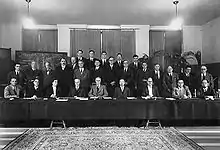André Guinier
André Guinier (1 August 1911 – 3 July 2000) was a French physicist who did important work in the field of X-ray diffraction and solid-state physics. He worked at the Conservatoire National des Arts et Métiers, then taught at the University of Paris and later at the University of Paris-Sud in Orsay, where he co-founded the Laboratory of Solid State Physics. He was elected to the French Academy of Sciences in 1971 and won the Gregori Aminoff Prize in 1985.
André Guinier | |
|---|---|
| Born | 1 August 1911 |
| Died | 3 July 2000 (aged 88) |
| Citizenship | France |
| Alma mater | École Normale Supérieure |
| Known for | X-ray crystallography, Guinier camera, Guinier's Law |
| Awards | Gregori Aminoff Prize (1985) |
| Scientific career | |
| Fields | Physicist |
| Institutions | Conservatoire National des Arts et Métiers (CNAM), University of Paris, Centre national de la recherche scientifique (CNRS) |
| Doctoral advisor | Charles Mauguin |

In the field of small-angle scattering he discovered the relationship of particle size to intensity which is called Guinier's Law.[1] He developed the Guinier camera for use in X-ray diffraction and contributed to the development of the electron microprobe by Raimond Castaing.
Together with Prof George Dawson Preston he also gives his name to the Guinier-Preston zone
Publications
- Guinier, André (1955) Small-angle scattering of X-rays. OCLC number: 01646250.
- Guinier, André (1963). "X-ray Diffraction. In Crystals, Imperfect Crystals, and Amorphous Bodies". W. H. Freeman and Co.
References
- Guinier, André (1939). "La diffraction des rayons X aux très petits angles : application à l'étude de phénomènes ultramicroscopiques". Annales de Physique. 11 (12): 161–237. Bibcode:1939AnPh...11..161G. doi:10.1051/anphys/193911120161.
Sources
- Obituary published in Acta Crystallographica
- Ravy S. André Guinier (1911–2000): a physicist among crystallographers //Physica Scripta. – 2015. – Т. 90. – №. 3. – С. 38001-38004.